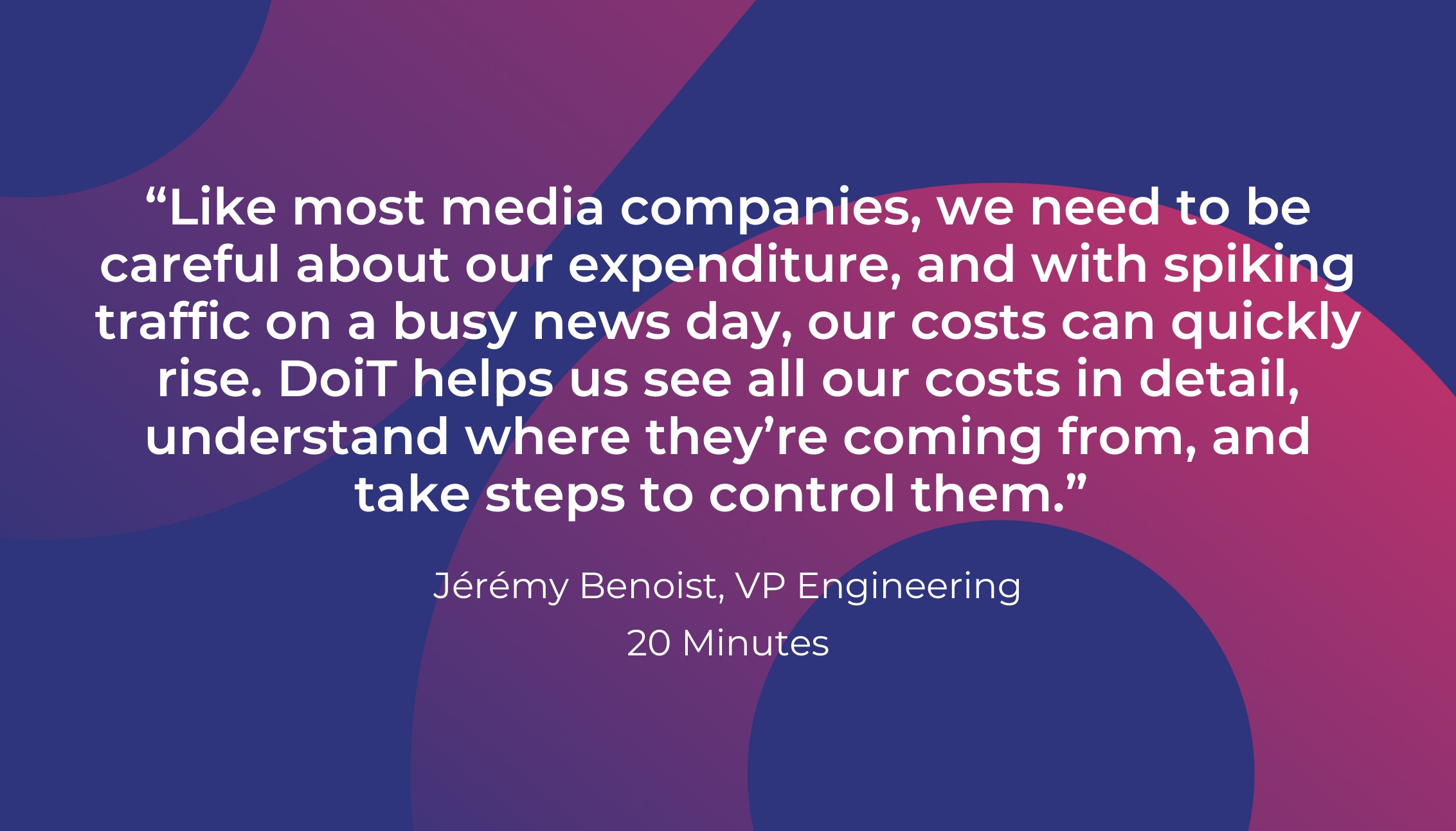20 Minutes: Turning cloud savings into news innovations

Meet 20 Minutes
20 Minutes is a free news publisher which also publishes a daily newspaper. Launched in Paris in 2002, it was originally aimed at French commuters, and has grown to become one of France’s leading news organizations, read by more than 20 million monthly users. With a focus on digital platforms, including its website and mobile app, 20 Minutes delivers up-to-the-minute news updates, insightful analysis, and engaging multimedia content.
The Challenge
20 Minutes began life as a free daily newspaper on the Parisian metro, its title the length of time commuters would spend reading the paper on their way to work. A website soon followed. And as 20 Minutes spread to other cities around France – its irreverent style popular with young, urban readers – it quickly became one of France’s top 10 news outlets.
However, the newspaper’s previous monolithic architecture, running on premise, struggled to keep up with its growth in readership. Spikes in traffic accompanying major news events would trigger outages, with journalists unable to publish stories and readers struggling to access articles on the mobile app. In need of a stable, reliable system, 20 Minutes decided to migrate to a serverless architecture on Amazon Web Services (AWS), while running a data analytics platform on Google Cloud.
Carrying out a phased migration over several years, 20 Minutes fixed its stability issues, but soon found that while running servers on premise was easy to budget for, with fixed monthly costs, the operational expenditure of serverless architecture was less straightforward.
“The downside of serverless is you can’t really predict the monthly costs, especially with spiking traffic,” explains Jérémy Benoist, VP Engineering at 20 Minutes. “When we moved the API to our mobile apps, with their high levels of traffic, we started to see a significant increase in our monthly cloud bill. That’s when we decided to work with DoiT.”
Impressed with the ability of the DoiT console to enable a full visualization of an organization’s cloud usage and expenditure, 20 Minutes began working with DoiT in 2021 to help understand its costs and keep its cloud spend under control.
The Solution
Visualizing and managing cloud expenditure with DoiT technology
With DoiT console, the 20 Minutes team can now see exactly what cloud resources it is using and their cost, both for its serverless infrastructure on AWS and for its data analytics workloads running on Google Cloud.
“The DoiT platform lets us analyze on a day-to-day basis the cost of our AWS Lambda usage, our Amazon S3 storage costs, and all our workloads,” says Jérémy. “We check it daily. It’s practically the first thing the CTO does when he arrives in the morning to understand what we spent the day before and whether we need to adjust anything to keep our costs in check.”
Something that the 20 Minutes team regularly adjusts to manage its costs is its caching. The news site pre-generates a large number of pages, which it caches, ready to be used when a journalist writes an article. This way, it can avoid spiking costs by creating its pages all at once. However, that pre-generation and caching can also be expensive, and 20 Minutes previously found it hard to understand which option was more cost efficient. Now, with the advance reporting from DoiT, Jérémy and his team can strike the right balance.
“The console allows us to see the big picture of all our costs,” he explains. “If we look at our dashboards and see the costs are rising, we can increase the cache for say 10 minutes, and then we will immediately see the costs coming back down within the day.”
Similarly, 20 Minutes can use the forecasting function in the console to predict its costs over a certain period. This helps it to keep its costs down in the face of traffic spikes by increasing or decreasing the cache accordingly.
Spotting spiking costs quickly with Anomaly Detection
As well as monitoring its cloud usage in the console, 20 Minutes uses Anomaly Detection to spot unexpected spikes in its cloud costs, enabling it to act quickly to resolve the issue. For example, every time a journalist posts a story, 20 Minutes uses AWS Step Functions to automatically sync the content with its partners. When a bug in its Step Functions configuration led to spiking costs, 20 Minutes immediately received an alert flagging the anomaly and prompting the team to look into the problem. They realized that the system was making too many calls to Step Functions, causing a sharp rise in costs.
“Thanks to Anomaly Detection we spotted the issue quickly and fixed the bug, and the next day we could see that Step Functions was going back to normal, saving us from having to wait until our monthly invoice arrived to spot and fix the issue,” Jérémy explains.
20 Minutes is also able to reduce its cloud costs further with DoiT Flexsave for Compute, which automatically allocates discounted rates to the company’s AWS compute workloads, reducing its on-demand costs and helping to lower its overall cloud bill.
Freeing up developers to develop new services
20 Minutes doesn’t just save money with the DoiT technology, but time. Without full visibility of its cloud usage, 20 Minutes had to spend a lot of time trying to diagnose and fix the cause of rising costs. For example, when the company experienced a problem with the development of its API, it was initially hard to understand what the issue was, and it took a lot of time and effort to resolve. “If we had the DoiT console at the time, we would have been able to identify the issue quickly and save around two weeks of development time,” says Jérémy.
With these time savings, the 20 Minutes team has been able to dedicate team members to more valuable projects, developing innovative services for its staff and readers. For example, two of Jérémy’s team were recently able to dedicate their time to developing a new generative AI tool to help journalists quickly reformat news stories received from the news wire service. This in turn allows the journalists to dedicate more of their own time to creating original content.
Access to cloud expertise on demand
20 Minutes maintains regular contact with the DoiT team, with a direct messaging channel for instant communication, as well as monthly check-ins to go through any outstanding issues. Whenever they need further support, the 20 Minutes team turns to DoiT Cloud Solve and a Cloud Reliability Engineer (CRE). “The DoiT CREs always react quickly and are precise both in their analysis of the problem and in the solutions they bring,” says Jérémy. “They help us to fix issues in a matter of days.”
The Results
Two full-time engineers free to focus on innovation
With DoiT technology making it easy to visualize and control costs, 20 Minutes has made time savings equivalent to two full-time engineering roles. As a result, it has been able to reassign two engineers to its genAI projects, investing resources in developing its core business, rather than cloud management.
9.2% savings on AWS workloads with Flexsave for Compute
With Flexsave for Compute automatically allocating discounted rates to applicable AWS workloads, 20 Minutes has saved 9.2% on the cost of those workloads.
$100s saved with Anomaly Detection
Anomaly Detection alerted 20 Minutes to the fact that its Step Functions expenditure had risen from $2 a day to $20 a day. As a result, it was able to fix the issue weeks before the arrival of its monthly cloud bill, reducing its spiking costs by 90% and saving the company hundreds of dollars.
What's Next?
20 Minutes’ current focus is migrating the remainder of its legacy infrastructure to its serverless environment, giving it greater stability and scalability. With more traffic expected on the platform as a result, 20 Minutes looks forward to continuing to work with DoiT on its cost optimization. “There is no question that we will carry on working with DoiT as we grow,” says Jérémy. “The Console is an essential part of our cloud costs management. We couldn’t control our spending without it.”
